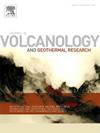佩尔萨梅火山(小安的列斯群岛)普林尼期喷发期间的火山灰沉降和柱崩塌动力学:公元前2.5 ka cal P5喷发
IF 2.4
3区 地球科学
Q2 GEOSCIENCES, MULTIDISCIPLINARY
Journal of Volcanology and Geothermal Research
Pub Date : 2025-02-16
DOI:10.1016/j.jvolgeores.2025.108295
引用次数: 0
摘要
马提尼克岛(小安的列斯群岛)的佩尔萨梅火山自2019年以来经历了火山动荡,并于2020年将警戒级别提高到黄色(警戒)。历史记录和实地研究表明,在过去的25年中,这座火山产生了许多圆顶形成和次普林尼期到普林尼期的喷发。公元前5世纪2.5千年的火山喷发将石蜡和火山灰分散到马提尼克岛北部。在此,我们利用火山泥粒散布和粒度分布的野外数据来估计火山喷发源参数,重建火山喷发的动力学演化过程。结果表明:P5次普林尼期喷发经过一个短暂的开启期后,形成了一个高26 km、向东北扩散的稳定柱。据估计,此次喷发总量为0.39±0.03 km3 DRE,为VEI 4级喷发。团块喷发速率从≈1.1 × 108 kg s - 1增加到≈4.8 × 108 kg s - 1,导致柱崩塌,火山侧翼形成火山碎屑密度流。从稳定柱到崩溃的转变发生在火山柱的一维模型很好地预测的条件下,并证实了这种喷发情景在过去的5年中在佩尔萨伊火山反复发生。P5喷发产物的火山扩散增强了当前危险图的准确性,并为更好地评估小安的列斯群岛的火山危险提供了火山学约束。本文章由计算机程序翻译,如有差异,请以英文原文为准。
Dynamics of tephra fallout and column collapse during Plinian eruptions of Mt. Pelée volcano (Lesser Antilles): The 2.5 ka cal BCE P5 eruption
Mt. Pelée volcano in Martinique (Lesser Antilles) has undergone volcanic unrest since 2019 and an increase of alert level to yellow (vigilance) in 2020. Historical records and field studies show that this volcano has produced numerous dome-forming and sub-Plinian to Plinian eruptions over the last 25 kyr. The 2.5 ka cal BCE P5 eruption dispersed lapilli and ash across the northern part of Martinique. Here, we present field data on tephra dispersal and grain-size distribution to estimate the eruption source parameters and reconstruct the dynamical evolution of the eruption. Our results show that after a short opening phase, the P5 Plinian eruption formed a 26 km-high stable column with a northeastern dispersal axis. The total volume of the eruption is estimated to be 0.39 ± 0.03 km3 DRE making P5 a VEI 4 event. The mass eruption rate increased from ≈ 1.1 × 108 kg s−1 to ≈ 4.8 × 108 kg s−1 leading to column collapse and the formation of pyroclastic density currents on the flanks of the volcano. The transition from stable column to collapse occurred at conditions well predicted by a 1D model of volcanic plumes and confirms that this eruptive scenario is recurrent at Mt. Pelée volcano over the last 5 kyr. The tephra dispersal of the P5 eruptive products reinforces the accuracy of the current hazard map and provides volcanological constraints to better assess volcanic hazards in the Lesser Antilles.
求助全文
通过发布文献求助,成功后即可免费获取论文全文。
去求助
来源期刊
CiteScore
5.90
自引率
13.80%
发文量
183
审稿时长
19.7 weeks
期刊介绍:
An international research journal with focus on volcanic and geothermal processes and their impact on the environment and society.
Submission of papers covering the following aspects of volcanology and geothermal research are encouraged:
(1) Geological aspects of volcanic systems: volcano stratigraphy, structure and tectonic influence; eruptive history; evolution of volcanic landforms; eruption style and progress; dispersal patterns of lava and ash; analysis of real-time eruption observations.
(2) Geochemical and petrological aspects of volcanic rocks: magma genesis and evolution; crystallization; volatile compositions, solubility, and degassing; volcanic petrography and textural analysis.
(3) Hydrology, geochemistry and measurement of volcanic and hydrothermal fluids: volcanic gas emissions; fumaroles and springs; crater lakes; hydrothermal mineralization.
(4) Geophysical aspects of volcanic systems: physical properties of volcanic rocks and magmas; heat flow studies; volcano seismology, geodesy and remote sensing.
(5) Computational modeling and experimental simulation of magmatic and hydrothermal processes: eruption dynamics; magma transport and storage; plume dynamics and ash dispersal; lava flow dynamics; hydrothermal fluid flow; thermodynamics of aqueous fluids and melts.
(6) Volcano hazard and risk research: hazard zonation methodology, development of forecasting tools; assessment techniques for vulnerability and impact.

 求助内容:
求助内容: 应助结果提醒方式:
应助结果提醒方式:


